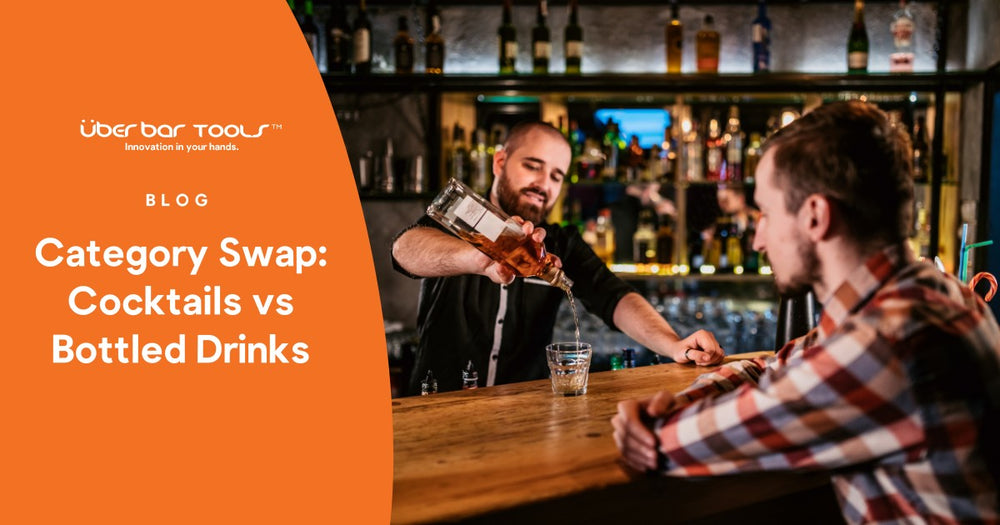
Category Swap is the process of a guest swapping a high-margin, higher-priced bartender-made drink for a bottled alternative. While at first, it might seem like a harmless choice, frequent category swaps can significantly impact your bar's profitability.
Here are the 4 important things to know about Category Swap:
- Why does category swap happen?
- What can category swap cost you?
- What are the signs to look out for?
- Conquering category swap
Why does category swap occur?
Consistency is the power of replication, delivering the same thing every time in the same way, irrespective of who makes the drink—helping a bar define what a successful, profitable guest drink experience is.
In a nutshell, category swap is the outcome of a business process failure, an inability to deliver consistency... consistently.
Inconsistency is the result of multiple failures:
- Insufficient investment in proper pouring and measuring tools
- Insufficient staff training and compliance
- Management oversight

What can category swap cost you?
Every time a guest swap out, from say, a $15 cocktail to a lower-priced $9 bottled alternative, there’s a real loss of $6 in sale revenue and an arising loss.
Yes, we appreciate that money’s entering the till, however the value of the sale and the amount of profit drastically reduces.
Let’s explore what the real impact is of a cocktail swapped to a bottled alternative using the $15 and $9 drinks example above:
First Drink: $15 cocktail at a 90% Gross Profit. *$13.50 = $15-$1.50.
Second Drink: $9 glass of wine at a 60% Gross Profit. *$5.40 = $9-$3.60.
*Gross Profit (GP) = Revenue - Cost of goods sold (COGS)
In the example, we see the $6 decrease in sales value leads to a $8.10 reduction in profit ($13.50-$5.40).
How many extra bottled drinks does one need to sell to the same or the next customer to make up the shortfall of a bartender-made drink?
In a sense, category swap may be considered a business process failure.
What are the signs to look out for?
A guest rarely will share with a bartender their first drink was unpleasant, they'll instinctively swap to a bottled alternative as it's consistent tasting.
Category swap is hard to measure, to do so one needs to consider a two-pronged strategy: anecdotal and inference.

Anecdotal
Serve staff should be trained/rewarded to report back on glasses collected with drinks partially consumed (between 50%-90%).
Some could say this exercise may cost more than what it’s worth.. maybe they’re right, however saying that we’d still suggest that this approach should be considered several times a year to monitor drinks consistency.
Inference
Most bars know the percentage and value of bartender-made drinks sold on average versus glasses of wine, bubbles, beer and ready-to-drink (RTDs). Sudden changes to these numbers may indicate an issue with category swap—remember to take into account seasonal and possible one-off factors such as weather, trading down due to economic factors.
Conquering category swap
If the data suggests an issue within consistency, then that’s the opportunity to review or eliminate causal factors such as:
- Tools - Provide bartenders with accurate, reliable and the best bar tools, such as speed pourers and jiggers, to help ensure consistent and balanced drinks.
- Training - Invest in regular training programs for staff, emphasize best practices and the standards for crafting cocktails.
- Reporting - Monitor outcomes by regular inspection to ensure they meet your standards. You can do surprise inspections or designated quality checks.
- Compliance: Encourage compliance by providing clear communication and guidelines. Offer rewards for exceeding expectations and consequences for repeated inconsistencies.
Famous American Chef Brian Duffy is renowned for the mantra 'inspect what you expect'.
Putting into place the physical tools and systems to educate, report, reward and reinforce creates an expectation that bar staff are always on their A-game to deliver a delicious, memorable and profitably made cocktail that a guest will order again and again.


